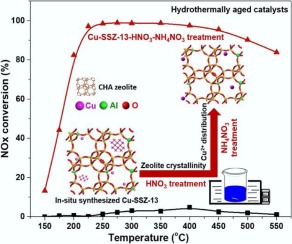Applied Catalysis B: Environment and Energy ( IF 20.2 ) Pub Date : 2020-01-20 , DOI: 10.1016/j.apcatb.2020.118655 Yulong Shan , Jinpeng Du , Yunbo Yu , Wenpo Shan , Xiaoyan Shi , Hong He

|
The origin of the beneficial effects of post-treatment processing with HNO3 and NH4NO3 solutions on the catalytic performance of copper-amine templated zeolites used in the NH3-SCR reaction was investigated. By careful design and optimization of the dual-treatment procedure (HNO3-NH4NO3), Cu-SSZ-13 catalysts were obtained using Cu-TEPA as a template that exhibited NOx conversion above 90% in a wide temperature window from 250 to 450 ℃ with GHSV of ∼ 400,000 h-1, even after hydrothermal aging at 750 and 800 ℃. The results of XRD and H2-TPR indicated that the HNO3 post-treatment adjusts the zeolite crystallinity and optimizes the copper species distribution in Cu-SSZ-13 catalysts. Further treatment with NH4NO3 reduces the Cu/Al ratios effectively and avoids the accumulation of Cu2+ ions to form CuOx clusters during hydrothermal aging. We investigated the influence of Cu2+ on the hydrothermal stability of Cu-SSZ-13, and two opposing effects were found. Cu2+ ions inhibit dealumination of the SSZ-13 zeolite structure, while excessive quantities of them easily accumulate to form CuOx clusters, leading to collapse of long-range order in the zeolite structure during hydrothermal aging. Before the zeolite structure collapses, Cu-SSZ-13 catalysts with high Cu loading exhibit higher NH3-SCR activity due to the preservation of more active Cu2+. However, Cu-SSZ-13 catalysts totally lose deNOx activity in NH3-SCR once the zeolite structure collapses. To guarantee both the activity for NOx reduction and hydrothermal tolerance, the optimal Cu loading (Cu/Al = 0.22∼0.31, here) and structural stability of in-situ synthesized Cu-SSZ-13 should be carefully tuned by HNO3 and NH4NO3 treatment.
中文翻译:

精确控制后处理可显着提高原位合成Cu沸石对NH 3 -SCR反应的水热稳定性
研究了用HNO 3和NH 4 NO 3溶液进行后处理对NH 3 -SCR反应中使用的铜胺模板沸石的催化性能的有益影响的根源。通过精心设计和优化双重处理程序(HNO 3 -NH 4 NO 3),使用Cu-TEPA作为模板获得了Cu-SSZ-13催化剂,该催化剂在250到250的宽温度范围内显示90%以上的NOx转化率。即使在750和800℃水热老化后,GHSV仍为450℃,GHSV为〜400,000 h -1。XRD和H 2 -TPR结果表明HNO 3后处理可调节沸石的结晶度并优化Cu-SSZ-13催化剂中的铜种类分布。NH 4 NO 3的进一步处理有效地降低了Cu / Al的比例,避免了在水热时效过程中Cu 2+离子的积累形成CuOx团簇。我们研究了Cu 2+对Cu-SSZ-13的水热稳定性的影响,发现了两个相反的作用。铜2+离子抑制SSZ-13沸石结构的脱铝,而过量的离子则容易积聚形成CuOx团簇,导致水热老化过程中沸石结构的长程有序塌陷。在沸石结构塌陷之前,由于保留了更多的活性Cu 2+,具有高的Cu负载量的Cu-SSZ-13催化剂表现出更高的NH 3 -SCR活性。但是,一旦沸石结构崩溃,Cu-SSZ-13催化剂在NH 3 -SCR中就会完全失去脱硝活性。为了同时保证NOx还原活性和耐水热性,应通过HNO 3和NH 4仔细调整最佳Cu负载量(此处的Cu / Al = 0.22〜0.31)和原位合成Cu-SSZ-13的结构稳定性。NO 3处理。









































 京公网安备 11010802027423号
京公网安备 11010802027423号